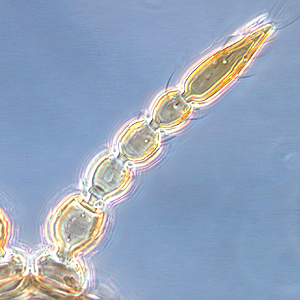Figures
Fig. 1: Antenna
Fig. 2: Head dorsal
Fig. 3: Pronotum
Fig. 4: Meso- and metanotum
Fig. 5: Meso- and metasternum
Fig. 6: Sternites V and VI
Fig. 7: Tergites V and VI
Fig. 8: Tergites VIII-X
ITS-RFLP gel patterns (1&8 ladder, 2 PCR-product, 3 RSAI, 4 HaeIII, 5 MspI, 6 HinfI, 7 AluI)
Fig. 9: Primer pair CS249/CS250
Fig. 10: Primer pair O1/18J
Fig. 11: Primer pair 18SMP/28SMP
Fig. 12: Primer pair TODA1/TODA2
Taxonomic Information
Species:
Aptinothrips rufus Haliday, 1836
Synonyms:
Aptinothrips groenlandica Richter,
1928
Aptinothrips intermedius Priesner, 1920
Uzelliella lubbocki Bagnall, 1908
Aptinothrips connaticornis Uzel, 1895
Thrips (Aptinothrips) nitidulus Haliday, 1836
Thrips (Aptinothrips) rufus Haliday, 1836
Common name:
Grass thrips
Present taxonomic position:
Family: Thripidae Stephens, 1829
Subfamily: Thripinae (Stephens) Karny, 1921
Genus: Aptinothrips Haliday, 1836
Species Recognition
Species Recognition
General information about the genus Aptinothrips:There are only five species in this genus and all are wingless, do not have ocelli, and they have 6 or 8 segmented antennae with simple sense cones on segments III and IV. All of the Aptinothrips species are found living in grasses.
Typical character states of Aptinothrips rufus:
Body color
Mainly brown or mainly pale or yellow, with some darker markings
Antennae
Number of antennal segments: 6
Segments II and III shape: more or less symmetric
Segments III & IV sensoria: emergent and simple
Base of sensorium on antennal segment VI: no more than 2 times as wide as base of nearest seta
Terminal antennal segments: rarely elongate
Head:
Head shape between compound eyes: not prolonged
Ocellar setae III on head: arising on anterior margin of, or in front of, ocellar triangle
Postocular setae I: present
Surface of head, pronotum and fore legs: without strong reticulate sculpture
Ocellar setae I in front of anterior ocellus: present
Prothorax
Number of pairs of elongate pronotal setae: 0-3
Number of pairs of elongate posteroangular pronotal setae: 0
Pronotum shape: rectangular
Mesothorax
Mesothoracic endofurca: with median spinula
Metathorax
Metanotum: without campaniform sensilla
Metanotum major sclerite: with only one major sclerite, this is at least twice as wide as long
Metanotum median area: with at least some equiangular reticulation
Metanotum sculpture: without dominant sculptured triangle medially
Metathoracic endofurca: transverse, sometimes with simple median spinula
Wings
Wings: absent
Legs
Fore tibial apex: not extending around fore tarsus
Mid and hind tarsi: with one segment
Abdomen:
Abdominal pleurotergites: not covered in microtrichia
Abdominal segment X: never tubular, longitudinally incomplete ventrally in both sexes
Abdominal sternite III of female: without glandular areas
Abdominal sternite VII: with discal setae present on median area
Abdominal sternite VII median marginal setae: arising in front of margin
Abdominal sternites IV , V and VI: with discal setae present medially as well as marginal setae
Abdominal tergites: without curved wing-retaining setae
Abdominal tergites IV & V median setal pair: much shorter than distance between their bases
Abdominal tergites V-VII: without paired ctenidia, sometimes with irregular microtrichia
Number of discal setae on sternite V: 10-20
Setae on abdominal tergite X: slender
Surface of lateral thirds of abdominal tergites: without regular rows of fine microtrichia
Ctenidia on tergite VIII: not present, but groups of microtrichia
Tergite VIII posteromarginal comb of microtrichia: absent
Biology
Life history:
As with other thrips species the life cycle from egg to adult is dependent on temperature. The full cycle can take less than one week to over a month and adults may live for more than one month producing several generations in one year depending on seasonal weather.
Host plants:
Grasses, Poaceae
Vector capacity:
None identified
Current known distribution:
Throughout the world in temperate climates.
Additional notes:
Males are not usually found in collections. All other life forms are found living in grasses and have been found in bird nests.
Bibliography
Moritz G, Morris DC, Mound LA (2001): ThripsID - Pest thrips of the world. ACIAR and CSIRO Publishing Collingwood, Victoria, Australia, CDROM ISBN 1 86320 296 X.
Moritz G, Mound LA, Morris DC, Goldarazena A (2004): Pest thrips of the world - an identification and information system using molecular and microscopial methods. CBIT, University of Queensland,CDROM ISBN 1-86499-781-8.
Mound, LA, & Marullo, R (1996): The thrips of Central
and South America: An Introduction (Insecta: Thysanoptera). Associated
Publishers, Gainesville.
Mound, LA & Walker, AK (1982): Terebrantia (Insecta:
Thysanoptera). Fauna of New Zealand (Number 1). Science Information Division,
DSIR Wellington, New Zealand.
Palmer, JM (1975): The grass-living genus Aptinothrips Haliday
(Thysanoptera: Thripidae). Journal of Entomology (B) 44: 175-188.
Stannard, LJ (1968): The thrips, or Thysanoptera, of
Illinois. Illinois Natural History Survey Bulletin 29: 215-552.
Links:
Mound, LA (2005): Thysanoptera (Thrips) of the World
- A Checklist. http://www.ento.csiro.au/thysanoptera/worldthrips.html













